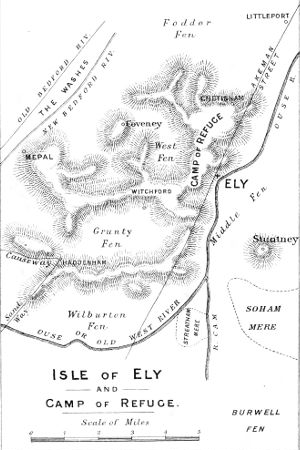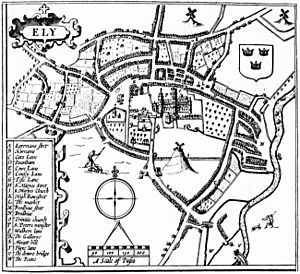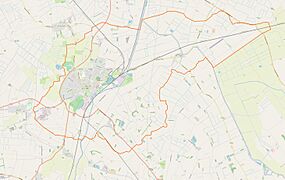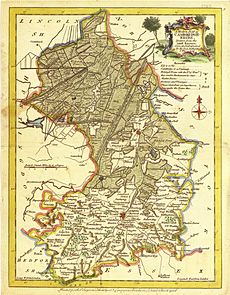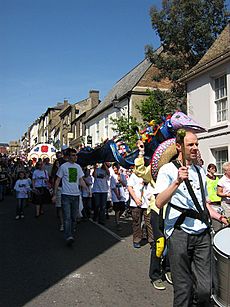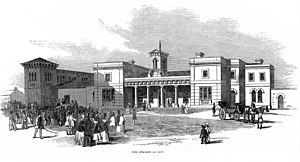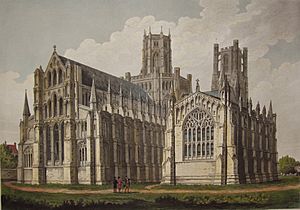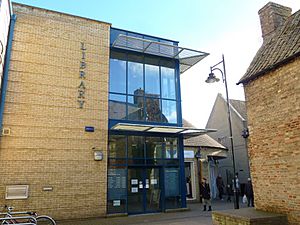Ely, Cambridgeshire facts for kids
Quick facts for kids Ely |
|
|---|---|
| Cathedral city | |
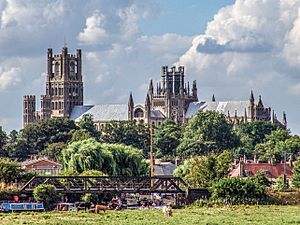 Ely Cathedral from the south-east |
|
| Area | 69 sq mi (180 km2) |
| Population | 19,200 (2021 census) |
| • Density | 278/sq mi (107/km2) |
| Civil parish |
|
| District |
|
| Shire county | |
| Region | |
| Country | England |
| Sovereign state | United Kingdom |
| Post town | ELY |
| Postcode district | CB6, CB7 |
| Dialling code | 01353 |
| Police | Cambridgeshire |
| Fire | Cambridgeshire |
| Ambulance | East of England |
| EU Parliament | East of England |
| UK Parliament |
|
Ely (pronounced EE-lee) is a beautiful cathedral city in Cambridgeshire, England. It's about 14 miles (23 km) northeast of Cambridge and 80 miles (129 km) from London. In 2021, about 19,200 people lived there.
Ely is special because it's built on a 23 square mile (60 km2) "island" of higher land in the middle of the Fens. This land is 85 feet (26 m) high, which kept it from getting waterlogged like the flat areas around it. Rivers like the River Great Ouse flow into the Fens. Before the Fens were drained, this area was full of marshes and lakes. Once drained, the land became very fertile, perfect for farming.
The River Great Ouse was once a main way to travel to Ely. The city stopped being a true island in the 1600s when the Fens were drained. Today, the river is popular for boating and has a big marina. Even though it's now surrounded by land, Ely is still known as the Isle of Ely.
Ely has two special nature spots called Sites of Special Scientific Interest. One is an old clay quarry, and the other shows how people used to farm in medieval times with "ridge and furrow" fields. The main work in the area is still farming. Long ago, before the Fens were drained, catching eels was very important. Some people think the city's name comes from this. People also used to hunt wild birds, dig for peat (a type of fuel), and harvest willow and sedge (types of plants). Ely was also a center for making pottery for over 700 years. A Roman road called Akeman Street goes through the city.
In 1753, a coach route connected Ely and Cambridge. This route was improved in 1769 and became a toll road. Today, the A10 road follows this old path. Ely railway station, built in 1845, is now a busy train hub. You can catch trains from here to many places like King's Lynn, Peterborough, Norwich, Ipswich, Cambridge, and London.
Ely has a long history of markets and fairs. In 1189, King Henry II allowed the first yearly fair, Saint Etheldreda's Fair. The word "tawdry" comes from the cheap lace sold at this fair. A weekly market has been held in Ely Market Square since at least the 1200s. Today, markets are held on Thursdays, Saturdays, and Sundays. There's also a farmers' market twice a month.
Fun events in Ely today include the Eel Festival in May, which started in 2004. There's also a fireworks display in Ely Park, which began in 1974. Ely has been a twin town with Ribe, Denmark's oldest town, since 1956. Ely City Football Club was formed in 1885.
Contents
- History of Ely
- Ely's City Status
- How Ely is Governed
- Geography of Ely
- Population of Ely
- Ely's Economy and Jobs
- Culture and Events in Ely
- Famous Landmarks in Ely
- Transport in Ely
- Religious Sites in Ely
- Sports in Ely
- Education in Ely
- Public Services in Ely
- Notable People from Ely
- Freedom of the City
- See also
History of Ely
Early Times in Ely
Roswell Pits, about 1 mile (1.6 km) northeast of Ely, is a special place for finding old fossils. In the 1800s and 1900s, people dug up clay here to make pottery and to fix river banks. Many fossils like ammonites (ancient sea creatures), belemnites, and bivalves were found. They even found a nearly complete pliosaur (a large marine reptile).
There's also some proof that people lived in Ely from the late Mesolithic (Middle Stone Age) to the Bronze Age. For example, Neolithic (New Stone Age) flint tools and Bronze Age axes have been found. More signs of life from the Iron Age and Roman times have been found, suggesting people lived here at least part of the year. A possible farm and some Roman pottery were found near the cathedral. A Roman settlement was also found in Little Thetford, 3 miles (4.8 km) south of Ely.
How Ely Got Its Name
The name "Ely" has a mysterious past, and experts still debate where it came from. The oldest record of the name is from the year 673, written as Elge. Many believe it comes from an Old English word meaning "district of eels," which makes sense given how important eel fishing was. This idea suggests the name eventually changed to mean "Eel Island."
However, some historians, like Mac Dowdy, point out that the word "eel" (or similar) wasn't used in English until much later. He suggests the city's name might come from "Elysium," a Latin word for paradise. This idea comes from a description of Ely as "an ancient place of great spiritual importance... a paradise."
Another idea is that the name comes from an old Celtic word. It could be from helig, meaning "willows," or heli, meaning "salt water."
Medieval Ely: Castles and Cathedrals
The city of Ely began with an abbey (a monastery led by an abbot) founded in 673 AD. This abbey was built about 1 mile (1.6 km) north of a village called Cratendune. It was protected by Saint Etheldreda, a queen who became a founder and abbess of Ely. She built a monastery in 673 AD, on the same spot where Ely Cathedral stands today.
Danish invaders destroyed this first abbey in 870. It was rebuilt and rededicated to Etheldreda in 970 by Ethelwold, who was the Bishop of Winchester. The abbots of Ely became very rich. By 1086, the Domesday survey (a big survey of England) said it was the "second richest monastery in England."
The first Norman bishop, Simeon, started building the cathedral in 1083. A part of the cathedral called the octagon was rebuilt between 1322 and 1328 after the original central tower fell down. Ely's octagon is seen as "one of the wonders of the medieval world." An expert named Nikolaus Pevsner called it the "greatest individual achievement of architectural genius at Ely Cathedral." This unique octagon gave the cathedral its famous nickname, "The Ship of the Fens." Building continued until the abbey was closed in 1539 during the Reformation. The cathedral was carefully repaired between 1845 and 1870. Because Ely has a cathedral and is the seat of a diocese, it has long been called a city. It was officially granted city status in 1974.

Cherry Hill is where Ely Castle once stood. This castle was built by the Normans, probably around 1070, by William the Conqueror. It was a strong defense against rebels. The castle was a "motte and bailey" type, with a mound 40 feet (12 m) high and 250 feet (76 m) wide.
King Henry III of England officially granted Ely the right to hold a market on April 9, 1224. However, Ely was a trading center even before this. Today, weekly markets are held on Thursdays and Saturdays, with special seasonal markets on Sundays and Bank Holiday Mondays.
Oliver Cromwell's Time in Ely
Oliver Cromwell lived in Ely from 1636 to 1646. He inherited St Mary's vicarage, a 16th-century house now known as Oliver Cromwell's House, from his uncle. You can visit this house today. While living in Ely, Cromwell worked as a tax collector. He was also a governor of Thomas Parsons' Charity, which helped local people since 1445.
Ely also had early forms of workhouses, places where poor people could live and work. One was built in 1725 for 35 people. Later, the Ely Union workhouse, built in 1837, could hold up to 300 people. This building later became Tower Hospital and is now homes.
Ely's Growth and Changes
After the 1300s, Ely faced some tough times, partly due to the plague and the closing of the monastery in 1539. Writers from the 1600s and 1700s described Ely as a small, quiet town. For example, William Camden wrote in 1607 that Ely was "not greatly to be counted off either for beauty or frequency."
However, Ely began to improve in the Victorian era (1837-1901) and the 20th century. Ely Cathedral was extensively restored between 1845 and 1870. This work was done carefully by architect George Gilbert Scott. The cathedral, standing 68 feet (21 m) above the fens, has always been a key landmark. It can be seen for miles around, earning its nickname "The Ship of the Fens."
For over 800 years, the cathedral and its buildings have shaped the city. Many of the medieval buildings around the cathedral are still used today.
The Liberty of Ely
Ely Abbey was given special rights and freedoms by King Edgar the Peaceful in the 900s. These rights were so strong that the bishops of Ely had powers similar to a ruler. The area around Ely was even sometimes called a "county palatine," meaning the bishop had royal authority there. These special powers of the bishop lasted until 1837.
Ely's City Status
Because Ely is the home of a diocese (the area a bishop oversees), it has long been seen as a city. Old maps from 1610 already called it a "Citie." Local councils in Ely also used "City of Ely" in their names for many years.
Ely's city status was officially confirmed on April 1, 1974, by Queen Elizabeth II. With a population of about 19,200 (in 2021), Ely is one of the smallest cities in England. However, its population has grown quite a bit since 1991, when it was around 11,291.
How Ely is Governed
Local Government in Ely
For elections to the UK Parliament, Ely is part of the Ely and East Cambridgeshire area.
Ely was governed by a local board from 1850 to 1894. Then, it became the City of Ely Urban District Council, which ran things until 1974. The Isle of Ely County Council governed the wider Isle of Ely area from 1889 to 1965. In 1965, this council joined with Cambridgeshire's council. In 1974, as part of a big change in local government, the City of Ely Urban District Council became the City of Ely Council. This is a parish council that covers the same area but with fewer powers. The East Cambridgeshire District Council now covers a larger area.
Geography of Ely
Land and Water in Ely
Western Cambridgeshire has limestone from the Jurassic period, while eastern Cambridgeshire has chalk from the Cretaceous period. The higher ground of the Isle of Ely is made of a type of rock called Lower Greensand, topped with Boulder Clay. All the towns nearby, like Stretham and Littleport, are on similar "islands" of higher ground. These islands rise above the flat land around them, which is the largest plain in Britain.
Before the 1600s, the low-lying fens around Ely were a mix of fresh and sea water. Major rivers like the River Witham, River Welland, River Nene, and River Great Ouse flow into this area. In 1774, Daniel Defoe called the Fens "the sink of no less than thirteen Counties." On November 23, 1774, John Wesley described how water covered the main road to Ely for a mile and a half.
Peat formed in the freshwater swamps, and silt was left by the slow-moving sea water. In the 1600s, Francis Russell, Earl of Bedford, with the help of Parliament, paid for the draining of the fens. This huge project was led by a Dutch engineer named Cornelius Vermuyden. The fens are still drained today.
Ely's Climate
Cambridgeshire is one of the driest counties in the British Isles, getting about 24 inches (610 mm) of rain each year. It's protected from cool coastal winds, so it has warm summers and cold, frosty winters. You can find weather forecasts and historical weather information from the UK Met Office. The closest weather station is in Cambridge.
Population of Ely
The Domesday survey in 1086 showed 110 households in Ely, mostly in the countryside. By 1251, there were 345 households, with more people starting to live in the town. In 1416, there were 457 occupied homes, and many streets were already laid out as they are today. By 1753, the population was 3,000.
| Year | 1801 | 1811 | 1821 | 1831 | 1841 | 1851 | 1861 | 1871 | 1881 | 1891 | 1901 | 1911 |
|---|---|---|---|---|---|---|---|---|---|---|---|---|
| Population | 3,948 | 4,249 | 5,079 | 6,189 | 6,849 | 7,632 | 7,982 | 8,166 | 8,171 | 8,017 | 7,803 | 7,917 |
| Year | 1921 | 1931 | 1941 | 1951 | 1961 | 1971 | 1981 | 1991 | 2001 | 2011 | 2021 | |
| Population | 7,690 | 8,381 | 9,988 | 9,803 | 9,966 | 10,392 | 11,291 | 15,102 | 20,256 | ~19,200 | ||
| Census: 1801–2021 | ||||||||||||
Ely's Economy and Jobs
Since Ely was an island surrounded by marshes, catching eels was very important. It provided both food and money for the abbot and local people. For example, in 1086, the village of Stuntenei had to give 24,000 eels to the abbot of Ely! Before the fens were drained, Ely was also a trading center for things made from willow, reeds, and rushes. Hunting wild birds was another big activity. People also dug for peat to use as fuel and building material.
Between 1850 and 1890, people in Ely dug up Phosphate nodules, called "coprolites," to use as fertilizer for farms. This gave many local people jobs. One of England's largest sugar beet factories opened near Ely in 1925. It closed in 1981, but sugar beet is still grown in the area.
Pottery was made in Ely from the 1100s until 1860. A type of pottery called "Babylon ware" was made in one part of Ely. This area was cut off from the city center when the River Great Ouse was rerouted around 1200. By the 1600s, this area was known as Babylon.
Culture and Events in Ely
Fun Annual Events
Ely has held yearly fairs since the 1100s. Saint Audrey's (Etheldreda's) fair, which lasted seven days, was first officially allowed by King Henry I in 1189. At this fair, cheap necklaces made of bright silk were sold. These were called "tawdry lace," and that's where the word "tawdry" (meaning cheap and showy) comes from today! Two other fairs were also held, but they stopped by the 1700s. Saint Etheldreda's fair still happens, though it's much shorter now.
Today, annual events in Ely include Aquafest, held by the Rotary Club on the first Sunday of July since 1978. Other events are the Eel Day carnival and the yearly fireworks display in Ely Park, which started in 1974. The Ely Folk Festival has been held in the city since 1985. The Ely Horticultural Society has had its Great Autumn Show since 1927. In 2018, Ely hosted its first "Pride" festival, celebrating LGBT people and diversity.
Ely's Twin Town
Since September 1956, Ely has been twinned with Ribe, Denmark's oldest town. Ribe is part of the Municipality of Esbjerg. Officials from Ribe first visited Ely in 1957. They celebrated their 50th anniversary of twinning in 2006, and exchange visits happen about every two years.
Museums and Places to Visit
Ely has several interesting places for visitors. The Stained Glass Museum is the only museum in the UK dedicated to stained glass. It's located inside Ely Cathedral and has a collection of stained glass from the 1200s to today.
Ely Museum, located in the old city jail, is a local history museum. It tells the story of Ely and the surrounding Fens from ancient times to now. Oliver Cromwell's House is the former home of Oliver Cromwell. It has an exhibition about Cromwell and the English Civil War.
Local Media
Local news and TV shows for Ely are provided by BBC East and ITV Anglia. Ely gets its TV signals from the Sandy Heath TV transmitter.
Ely's local radio stations are BBC Radio Cambridgeshire (96.0 FM), Heart East (103.0 FM), and Star Radio (107.1 FM). Local newspapers include the Ely Standard and Cambridge News.
Famous Landmarks in Ely

War Memorial Cannon
A cannon, captured during the Crimean War at the Siege of Sevastopol (1854–1855), was given to Ely by Queen Victoria in 1860. It's located on Palace Green, west of the cathedral. The inscription says it was given to mark the creation of the Ely Rifle Volunteers. The cannon was made in Russia in 1802.
Important Buildings in Ely
Ely has many historic buildings. There are 23 buildings listed as Grade I, meaning they are of exceptional interest. Six are Grade II*, and 153 are Grade II.
Cherry Hill, south of Cathedral Park, is what's left of Ely Castle. This Norman castle was built around 1070. It was a "motte and bailey" castle, with a mound 40 feet (12 m) high and 250 feet (76 m) wide.
Two hospitals from the 1100s, St Mary Magdalene and St John the Baptist, were on the site of what is now a farmstead in West End. Parts of these old buildings still exist.
John Alcock, a Bishop of Ely, built the Bishop's Palace between 1486 and 1500. Only parts of the original building remain. A huge London Plane tree, planted in 1680, still grows in the garden and is one of the largest in England. This building is a Grade I listed building and is near the cathedral.
St Mary's Vicarage, also known as Cromwell's House, is a Grade II* listed building from the 1500s. A plaque says it was "the residence of Oliver Cromwell from 1636 to 1647." The house is now a museum about 17th-century life and a tourist information center. The former Ely Gaol (jail) is a Grade II listed building from the late 1600s and is now the Ely Museum.
The Maltings is another important building in Ely. Built in 1868, it was part of a brewery that processed barley into malt for beer. The Maltings is on Ely's Waterside. Today, it's a place for events, weddings, and conferences. It also displays the Ely-Ribe Tapestry, which was made in 2004 to celebrate 50 years of twinning between Ely and Ribe, Denmark.
The Lamb Hotel is a Grade II listed building on the corner of Lynn Road and High Street, near the cathedral. It was built in 1828-1829 as a coaching house (a place where horse-drawn coaches would stop). It had stables for 30 horses. An inn is believed to have been on this site since the 1400s.
Ely's courthouse was built in 1821. It stopped being a court in 2011 and was bought by the City of Ely Council in 2013 to use as their offices and meeting place.
Special Natural Sites
The old clay quarry, Roswell Pits, is now a nature reserve and a Site of Special Scientific Interest (SSSI). The trees in Abbey Park were planted on Mount Hill in 1779. Mount Hill was renamed Cherry Hill after these trees were planted. Chettisham Meadow SSSI is a medieval ridge and furrow grassland about 0.6 miles (1 km) north of the city center. This site is one of the best examples of old farming methods in the UK and has rare plants like the Green-winged Orchid.
Transport in Ely
Train Travel in Ely
Ely railway station, on the Fen Line, is a very important train hub. The train line from Cambridge to Ely opened in 1845. Five major railway lines branch out from Ely, connecting it to places like King's Lynn, Peterborough, Norwich, Ipswich, Cambridge, and London. When the Lynn and Ely railway opened in 1847, the Ely station building was described as "an extensive pile in pleasing mixed Grecian and Italian style."
An old railway line, the Ely and St Ives Railway, opened in 1865 but was never very popular. It closed to passengers in 1931 and completely in 1964. Today, train companies like Great Northern, Greater Anglia, CrossCountry, and East Midlands Railway use Ely station. You can get direct trains to Cambridge, London, most of East Anglia, the Midlands, and the North of England. There are also connecting services to many other parts of England and Scotland.
Roads Around Ely
A Roman road called Akeman Street is said to have run from near Wimpole through Cambridge, Stretham, and Ely to Brancaster. However, the street in Ely called Egremont Street, which runs east to west, cannot be the Roman road, as the Roman road would have gone north-south through the center of Ely.
In the 1700s, a coach service ran three times a week from the Lamb Inn in Ely to Cambridge. In the 1760s, a local clergyman encouraged people to pay for a turnpike road (toll road) between Ely and Cambridge, which improved travel. The A10 road from London to King's Lynn passes through Ely. A bypass was built southwest of the town in 1986.
A new bypass for the A142 road, southeast of Ely, was completed on October 31, 2018. This bypass helps reduce traffic in Ely and avoids a low bridge on the railway line that often caused problems for tall vehicles.
River Transport
Local rivers were once very important for transport but are now mostly used for fun. The Great Ouse connects Ely to the sea at King's Lynn, and the River Cam flows from Cambridge to join the Great Ouse south of Ely. Long ago, King Cnut arrived at Ely by boat. Old records from 1291-1292 show that people traveled by river to buy goods in other towns. In 1753, a boat left Ely every Tuesday and Friday for Cambridge, taking six hours for the 20-mile (32 km) journey.
Religious Sites in Ely
Ely Cathedral: The Ship of the Fens
The Anglican Cathedral Church of the Holy and Undivided Trinity is famously known as the "Ship of the Fens." This name comes from how its tall towers can be seen from far away across the flat wetlands of "The Fens."
The diocese of Ely was created in 1108, and the bishopric (the area a bishop oversees) was founded a year later. Building the cathedral began in 1083 under William the Conqueror and was finished in 1189. On February 22, 1322, the central part of the cathedral collapsed, but it was rebuilt as a unique octagon. The cathedral was fully completed in 1351. John Wesley, who visited in 1774, called it "one of the most beautiful I have seen."
Ely is the closest cathedral city to Cambridge, and both are in the same diocese. The Diocese of Ely covers a large area, including most of Cambridgeshire and parts of Norfolk, Peterborough, Essex, and Bedfordshire. It serves about 641,000 people and has 335 churches.
Other Churches in Ely
St Mary's Church is an early 13th-century building with a spire and tower from around 1300. It was heavily restored starting in 1877. The Roman Catholic Church of St. Etheldreda, built in 1891, is on Egremont Street. The Methodist chapel, built in 1818, was restored in 1891. The Salem Baptist chapel was built in 1840. The Church of St Peter-in-Ely on Broad Street was built in 1890. The Countess Free Church is also in Ely. From 1566 to 1938, the Lady Chapel of Ely Cathedral served as the parish church for Holy Trinity.
Sports in Ely
Ely City Football Club was started in 1885. They joined the Eastern Counties Football League in 1960 and have been in the league's Premier Division since 2007. Ely Tigers Rugby Club plays in the London 3: Eastern Counties Division.
The University of Cambridge rowing club has a boathouse on the river in Ely. They train here for the yearly Boat Race against the University of Oxford. In 1944 and 2021, the Boat Race itself was held on the River Great Ouse near Ely. This happened because of World War II and the COVID-19 pandemic. The Isle of Ely Rowing Club was formed to remember the 1944 event.
In 1973, Ely won the international Jeux Sans Frontières competition (known in Britain as It's a Knockout!). Ely was the last British town to win this title.
Education in Ely
King's Ely is a school for both boys and girls that offers boarding. It received a special royal charter in 1541 from King Henry VIII. The school traces its beginnings back to the re-establishment of St Etheldreda's monastery in 970. In those days, wealthy families sent their sons to places like this to learn to read and translate Latin. Some even believe Edward the Confessor might have been educated at Ely around 1005-1010. The teaching of grammar at the monastery led to the Cathedral Grammar School, which is now King's Ely.
Needham's Charity School was founded in 1740 by Mrs Catherine Needham. It provided education, clothing, and apprenticeships for poor children. It started with 24 free students aged 9 to 14. After moving a few times, Needham's School moved to a new building in Downham Road in 1969. The original building is now part of King's Ely.
There were also National Schools for boys and girls in Ely. The Broad Street School was built in 1858. Later, the Silver Street and Broad Street schools became St Mary's Junior School.
Ely High School for Girls opened in 1905. In 1972, Ely High School closed when the local secondary education system changed. The site then became the City of Ely VIth Form College, which is now part of Ely College.
During World War II, the Bishop's Palace was used as a hospital. After the war, it became The Palace School for children with disabilities.
Today, schools in Ely include: King's Ely; Ely College; The Lantern Community Primary School; St Mary's CofE Junior School; Isle of Ely Primary School; St John's Community Primary School; and Highfield Special Academy.
Public Services in Ely
Anglian Water provides Ely's water and sewerage services. The water quality was reported as excellent in 2011. The water is quite hard. The closest reservoir, Grafham Water, is 21 miles (34 km) west of the city.
EDF Energy supplies electricity to Ely. The world's largest straw-burning power station is nearby in Sutton. This power station uses biomass (like straw) to create 36.85 MW of renewable energy.
East Cambridgeshire District Council is part of a partnership that won an award for its waste and recycling efforts in 2006–07.
The Princess of Wales Hospital in northern Ely was built by the Royal Air Force during World War II. It served nearby RAF bases until 1993. In 1987, Diana, Princess of Wales renamed the hospital. It is now a community hospital that treats about 40,000 outpatients each year. For more serious cases, people go to other hospitals in the region, such as Addenbrooke's Hospital in Cambridge, which is 20 miles (32 km) south of Ely.
Notable People from Ely

Many children of RAF parents were born in Ely because of the former RAF hospital there. These include rugby union player and Rugby World Cup 2003 winning manager, Clive Woodward. Also, actors Guy Pearce, Sam Callis, Simon MacCorkindale, and David Westhead were born in Ely. Autogyro world record-holder Ken Wallis was also born here. Other famous people from Ely include The Sisters of Mercy singer Andrew Eldritch, journalist Chris Hunt, and award-winning poet Wendy Cope.
Freedom of the City
The "Freedom of the City" is a special honor given to individuals and military units. Here are some who have received it in Ely:
Individuals
- Malcolm Fletcher, saxophonist with the Ely Military Band: December 18, 2017.
Military Units
- RAF Hospital Ely, 1977
- RAF Strike Command: September 26, 1987.
- 6th Battalion The Royal Anglian Regiment: 1977.
- 1094 (City of Ely) Squadron Air Training Corps: October 8, 2019
- (City of Ely Detachment) 3 (Ironside) Company Cambridgeshire Army Cadet Force: June 24, 2023.
|
See also
 In Spanish: Ely para niños
In Spanish: Ely para niños



